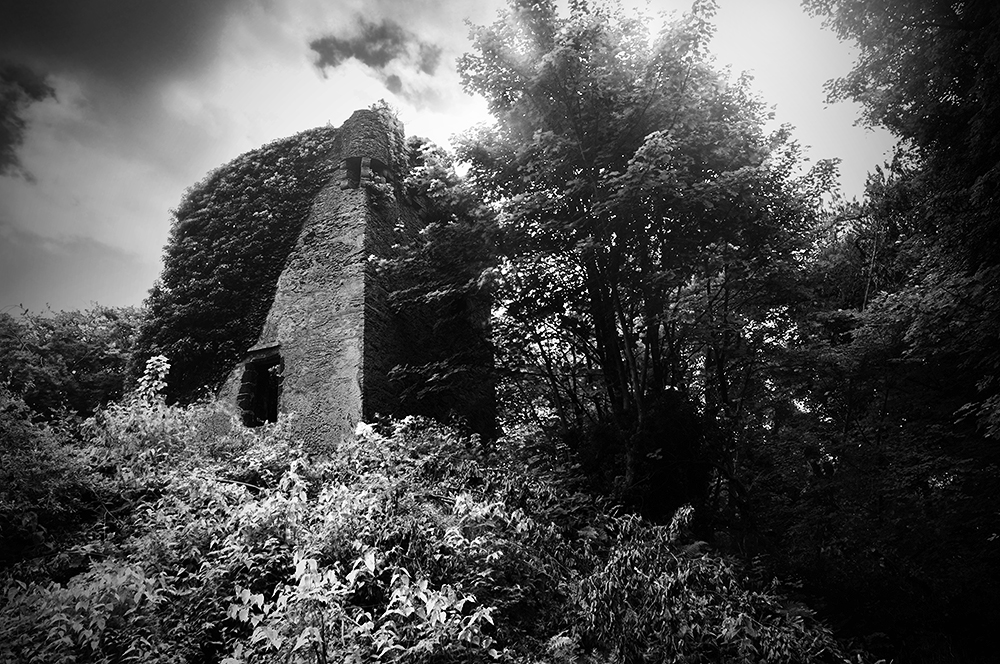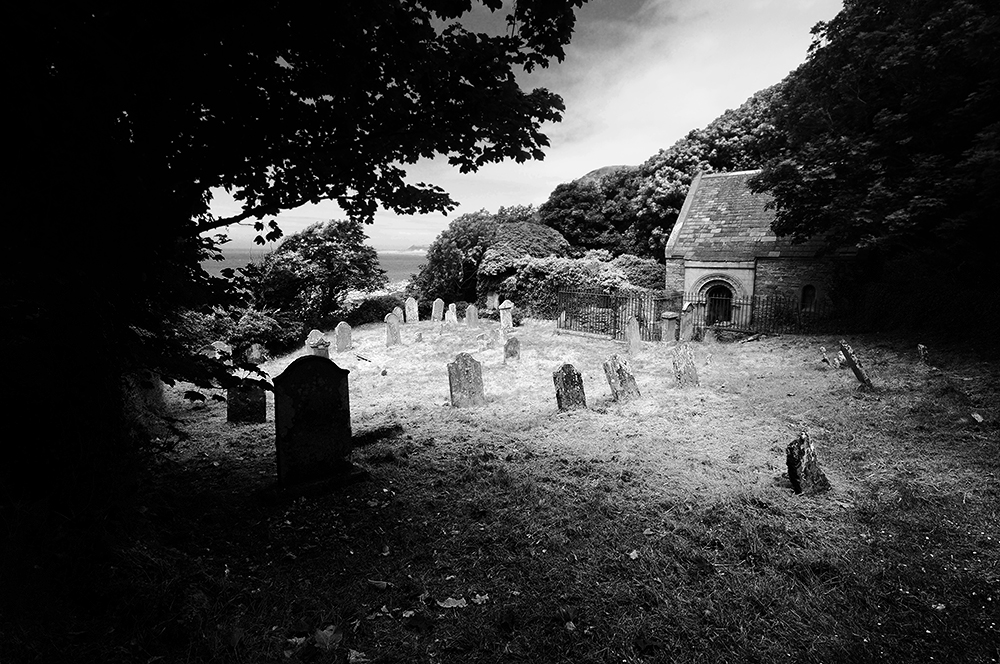Keep me, my good corn, and my sheep and my bullocks
From Satan, from Sin, and those thievish McCullochs.
A Manxman’s Prayer

Myrton Castle now stands ruined and overgrown, hidden from view by trees, slowly crumbling on its mound in the grounds of Monreith House. A relic of a long-gone age, when fire and sword were often gleefully employed in settling an argument.
One of Galloway’s oldest names, the McCullochs had a fearsome reputation as a clan not adverse to conflict and feud. They held sway over Southern Galloway from the medieval period through to early modern times, said to be descended from Ulgric, who led the Gallovidians in King David I’s army at the Battle of the Standard in 1138. Like many old Galloway families, their first known documented mention in the area, is in the Ragman Roll of 1296, declaring an oath of fealty to Edward I1.
The McCullochs may have come by their lands in Wigtownshire due to their support of Lochlann (Roland) in his conflict over the Lordship of Galloway against his uncle Gilbert, late in the 12th century2. Their support of Edward I and John Balliol, son of Lady Dervorguila of Galloway, rather than Robert the Bruce, lost them their lands. They were at least partially restored however under David II, around 13633.
Little seems to be known about the early history of Myrton Castle. The motte is presumed to date from the 12th century and in the usual manner, would have been topped with a wooden building. The stone tower house dates from the 15th century, with 17th century modifications4.
The first recorded McCulloch owner of Myrton was Sir Patrick, named in English records in 13385, but it is the infamous Sir Alexander McCulloch from who the clan’s most fearsome reputation derives. A favourite of James IV, he was the King’s falconer, received visits from the King at Myrton Castle, when on his pilgrimages to Whithorn and was knighted by 1488.
Around 1497, Sir Alexander was for a short time appointed as the Sheriff of Wigtown, deputising for the ailing Quentin Agnew. Although his tenure as Sheriff was relatively short, he attacked and burned down Dunskey Castle, home of William Adair of Kithilt. Not yet content, he then moved on to Ardwell Castle, home of his kinsman Archibald McCulloch, driving off his cattle, sheep, horses and household goods6.
Sir Alexander also managed to incur the wrath of Bishop Vaux. When Mitchell McBriare was found liable for a debt of £10, he appealed to the Bishop, who forbade the Sheriff to foreclose on McBriare’s goods. Sir Alexander, resenting the Bishop’s interference accompanied his officers and instructed them to do their duty. The Bishop promptly placed a curse upon McCulloch.
“Whereupon, Bishop Vaux solemnly cursed Sir Alexander, ‘Knycht of Myrton’, he cursed the Sheriff Clerk, he cursed the sergeants and other officers whomsoever; he cursed them all ‘by candle, by book and by bell’: and then, committing the curses to writing, he caused Letters of Cursing to be served on all parties.”7
In 1507, Thomas Earl of Derby, Lord of the Isle of Man, attacked the Galloway coast, nearly destroying the town of Kirkcudbright. McCulloch unleashed furious reprisals, visiting raid after raid upon the island. It is said that Manxmen at mealtimes would finish their meat before their soup, so to at least have eaten something substantial before McCulloch’s next visit. He became so infamous, he passed into popular Manx culture as ‘Cutler’ McCulloch8.
“God keep the house and all within
From Cut McCulloch and from sin.”
The final McCulloch owner of Myrton was Godfrey McCulloch, who is also the possessor of the dubious honour of being the final person to be beheaded by the ‘Maiden’ (a guillotine like structure) at the Mercat Cross in Edinburgh. Mired in debt, Godfrey sold Myrton to William Maxwell in 1683, but his situation was soon to get much worse. The McCulloch’s old feud with the Gordons reached its apex when on 2nd October 1690, Godfrey went to William Gordon’s house at Bussabiel to secure the release of impounded cattle. Gordon answered the door with a gun in hand and McCulloch shot him in the thigh, causing wounds from which Gordon later died. Godfrey fled abroad to England, where he remained for six years, returning to Scotland once he believed the matter had blown over. But one Sunday in a church in Edinburgh, he was recognised by a Galloway man who cried, “Steik the door, there’s a murderer in the house9.”
Godfrey McCulloch was tried and executed in 1697, but there is another, more supernatural version of the ending of this tale. In the early days of his ownership of Myrton Castle, Godfrey ordered a drain to be cut in the mound, when a little man in a green coat appeared to protest that the mound was the home of fairies and drain was being cut through their house. The fairy promised if he stopped, he would one day receive a great reward, but if he didn’t, he would have to face the wrath of the fairies. Godfrey had the drain diverted. On the day of his execution, Godfrey was said to have been rescued by a little man, dressed in green upon a white horse and spirited away, never to be seen again10.
Myrton Castle remained in use until Monreith House was built by Sir William Maxwell, 4th Baronet, in 1791 on the site of Myrton village. The castle was converted to a doocot around 1800.

Kirkmaiden Church near Monreith, thought to be one of the oldest churches in Scotland, is the ancient burial place of the McCullochs and has long held a rather eerie reputation, with numerous legends attached to it. Long ago, a merry gathering was held at the old house of Moure, the original home of the Maxwells of Monreith, now known as Dowies. As the night wore on, talk turned to dark tales of bravery and one foolhardy young man accepted a wager that he should ride to Kirkmaiden and return with the church bible to prove he’d been there. Night ceded to morning and still the young man had not returned. His body was later found in a bleak place, next to that of his horse, with both of their entrails twisted around a thorn bush. It seemed he had reached the church and was on his way back when he met his fate11.
Sometime before Andrew Symson wrote his ‘Large Description of Galloway’ in 1684, the parish of Kirkmaiden merged with Glasserton. The bell and pulpit were taken across Luce Bay to the other, newly built Kirkmaiden church in the Rhins. Although it was a clear and still day, a storm blew up in which the ship floundered and sank. Now and again, much like the prophetic howl of the banshee, the bell can be heard to toll from the watery depths of the bay, signifying the death of a McCulloch is approaching12.
Sources
1. A History of the Galloway Families of McCulloch – Walter Jameson McCulloch (1964)
2. Galloway. A Land Apart – Andrew McCulloch (2000)
3. W.J. McCulloch (1964)
4. Canmore website: https://canmore.org.uk/site/62795/myrton-castle
5. W.J. McCulloch (1964)
6. W.J. McCulloch (1964)
7. W.J. McCulloch (1964)
8. W.J. McCulloch (1964)
9. Highways and Byways in Galloway and Carrick – Dick (1924)
10. A History of Dumfries and Galloway – Herbert Maxwell (1896).
11. Witchcraft and Superstitious Record in the South-Western District of Scotland – Maxwell Wood (1911)
12. Maxwell Wood (1911)